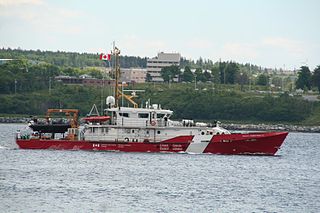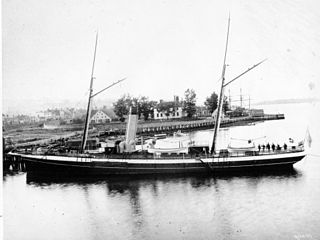
The Canadian Coast Guard is the coast guard of Canada. Formed in 1962, the coast guard is tasked with marine search and rescue, communication, navigation, and transportation issues in Canadian waters, such as navigation aids and icebreaking, marine pollution response, and support for other Canadian government initiatives. The coast guard operates 119 vessels of varying sizes and 22 helicopters, along with a variety of smaller craft. The CCG is headquartered in Ottawa, Ontario, and is a special operating agency within Fisheries and Oceans Canada.

CCGS Leonard J. Cowley is an ice-strengthened fisheries patrol vessel of the Canadian Coast Guard. The ship entered service in 1984 and is still currently in service. During the Turbot War, the patrol vessel took part in the detainment of the Spanish fishing vessel Estai. Leonard J. Cowley's home port is St. John's, Newfoundland and Labrador.

CCGS John P. Tully is an offshore oceanographic science vessel in the Canadian Coast Guard operating out of Pacific Region at CGS Base Patricia Bay in Sidney, British Columbia. Prior to 1995, the ship was assigned to Fisheries and Oceans Canada. The vessel entered service in June 1985 with the Department of Fisheries and Oceans on the West Coast of Canada. In 1995, the fleets of Fisheries and Oceans and the Canadian Coast Guard were merged under Canadian Coast Guard command and John P. Tully became a Coast Guard vessel.

CCGS Hudson is an offshore oceanographic and hydrographic survey vessel operated by the Canadian Coast Guard. The ship entered service in 1963 with the Canadian Oceanographic Service, stationed at the Bedford Institute of Oceanography, called CSS Hudson. The ship made several significant scientific voyages, among them the first circumnavigation of the Americas in 1970. The ship was transferred to the Canadian Coast Guard in 1996 and remains in service.

CCGS Alfred Needler is an offshore fishery science vessel operated by the Canadian Coast Guard. The vessel entered service in 1982 with the Department of Fisheries and Oceans, stationed at the Bedford Institute of Oceanography in Dartmouth, Nova Scotia. In 1995, in order to reduce the number of ships and combine tasks, the Fisheries and Oceans fleet and the Canadian Coast Guard fleets were merged under the Canadian Coast Guard. Alfred Needler is currently in service.

The Marine Museum of Manitoba, at Selkirk, Manitoba, was established in 1972 to gather ships, artifacts, and items relating to shipping, to tell the story of the development and the operation of transportation on Lake Winnipeg and the Red River. The period covered by the Museum's displays starts circa 1850 and continues to present day.
CCGS Brant was a Canadian Coast Guard vessel in service between 1928 and 1966. Stationed on the East Coast of Canada, Brant was deployed as a navigation aids tender. Brant was the last coal-burning vessel in Canadian government service.
CCGS C.P. Edwards was a Canadian Coast Guard ship. Entering into service as a coastal freighter in 1946 with the name Ottawa Mayhill, it was commissioned in 1947 as CGS C.P. Edwards for the Department of Transport's Marine Service, serving as a light vessel. C.P. Edwards was transferred into the newly created Canadian Coast Guard in 1962, and was decommissioned in 1972. The vessel was sold to private interests that year. An engine was acquired by Canadian Science and Technology Museum in 1976. The Canadian registry of the vessel was closed in 1979 and the ship was sold to U.S. interests.
CCGS N.B. McLean was a Canadian Coast Guard icebreaker. Constructed in 1930 at Halifax Shipyards, she entered service as CGS N.B. MacLean and served in the Department of Transport's Marine Service, using the prefix "Canadian Government Ship". The ship was transferred into the newly created Canadian Coast Guard in 1962. She served in the St. Lawrence River and Gulf of St. Lawrence until she was decommissioned in 1979, and taken to Taiwan to be scrapped in 1989. She was replaced by CCGS Pierre Radisson.
CCGS D'Iberville was a Canadian Coast Guard icebreaker that was in service from 1952 to 1983 and was Canada's first modern icebreaker. The ship commissioned as CGS D'Iberville for the Department of Transport's Marine Service, using the prefix "Canadian Government Ship", D'Iberville was transferred into the newly-created Canadian Coast Guard in 1962. When launched, she was the largest icebreaker in use by Canada post-World War II until CCGS John A. Macdonald was put in service. In 1984, the icebreaker was renamed Phillip O'Hara before returning to her old name in 1988. In 1989 the vessel was sold for scrap and broken up at Kaohsiung, Taiwan.

CCGS Gordon Reid is a offshore fisheries patrol vessel of the Canadian Coast Guard. The vessel entered service in 1990 on the West Coast of Canada and is still in active service. In 2014, Gordon Reid responded to the distress signal of MV Simushur which had lost engine power off the coast of Haida Gwaii in British Columbia.

The Hero-class patrol vessels, previously the Mid-Shore Patrol Vessel Project, is a series of nine patrol vessels constructed by Halifax Shipyards for the Canadian Coast Guard. Based on the Dutch Damen Stan 4207 patrol vessel, construction began in 2011 and the first vessel entered service in 2012. The vessels are assigned to both coasts of Canada, used for coastal patrol duties.
CCGS Wilfred Templeman was a Canadian Coast Guard fisheries research vessel that entered service 1981 with the Department of Fisheries and Oceans. In 1995 the Fisheries and Oceans and Canadian Coast Guard fleets were amalgamated and Wilfred Templeman joined the Canadian Coast Guard. The research vessel patrolled the coast off Newfoundland and Labrador. In 2011, the vessel was taken out of service, sold to commercial interests and renamed Blain M.
CCGS Earl Grey is a Samuel Risley-class light icebreaker and buoy tender in the Canadian Coast Guard. Constructed in 1986, the vessel serves a variety of roles, including light ice-breaking and buoy tending, as well as being strengthened for navigation in ice to perform tasking along the shores off the Atlantic coast of Canada. Like her sister ship, CCGS Samuel Risley, she carries a large and powerful crane on her long low afterdeck for manipulating buoys. Earl Grey is the second icebreaker in Canadian service to carry the name.

CGS Acadia was a fisheries patrol vessel of the Canadian Department of Marine and Fisheries from 1885 to 1909. The ship began life as the yacht Yosemite, constructed in the United States in 1880. After being acquired in 1885 by Canada and renamed Acadia, the ship served in the Atlantic fisheries, enforcing fisheries regulations in Canadian waters. The ship was taken out of service in 1909 and sold for scrap and Acadia's registry was closed in 1910.

CGS Stanley has been described as Canada's first effective icebreaker. She was launched in 1888, and remained in service until 1935. Constructed in the United Kingdom, Stanley was deployed along the East Coast of Canada for use as a ferry and lighthouse and buoy supply vessel and was used for icebreaking during winter months.

CGS Kestrel was employed as a Government of Canada Fisheries Protection vessel on the Pacific Coast. Completed in 1899 by Alfred Wallace shipyards in Vancouver, British Columbia she entered into service in 1903 and remained in government service after the creation of the Royal Canadian Navy in 1910 until she was sold in 1912. The vessel was broken up in 1931.

CGS C.D. Howe was a Canadian Arctic patrol vessel tasked with controversial missions that served first with the Department of Transport, then the Canadian Coast Guard. Conceived as a way to make Canada's presence in the Arctic more visible, C.D. Howe entered service in 1950. The ship would make an annual voyage to Canada's north in the summer months, visiting remote communities to resupply them and to provide medical and dental services. The patrol vessel would sometimes remove members of Aboriginal communities to the south for further treatment. The ship was also involved in a forced resettlement of Inuit families in the High Arctic. During winter months, C.D. Howe provided services in the Gulf of St. Lawrence. In 1962, the ship joined the Canadian Coast Guard and was given the new prefix CCGS. C.D. Howe was deemed obsolete in 1969 and taken out of service. In 1970 the vessel was sold, becoming an accommodation vessel in Greenland before being broken up for scrap in 1975.

CCGS Tanu is a fisheries patrol vessel in service with the Canadian Coast Guard. The ship was constructed in 1968 by Yarrows at their yard in Esquimalt, British Columbia and entered service the same year. Home ported at Patricia Bay, British Columbia, the ship is primarily used to carry out fisheries patrols and search and rescue missions along Canada's Pacific coast.













